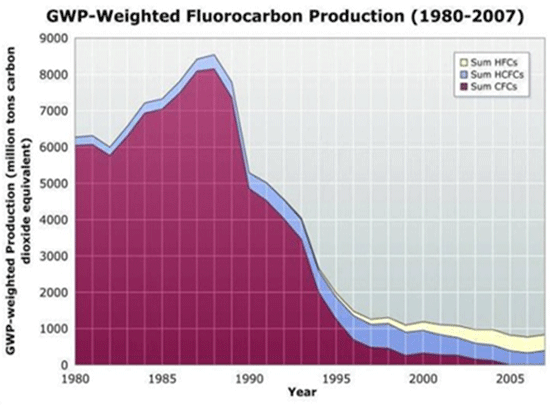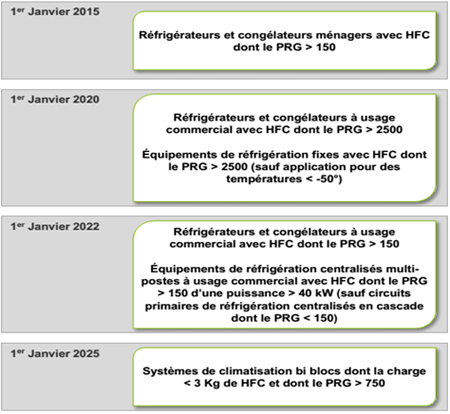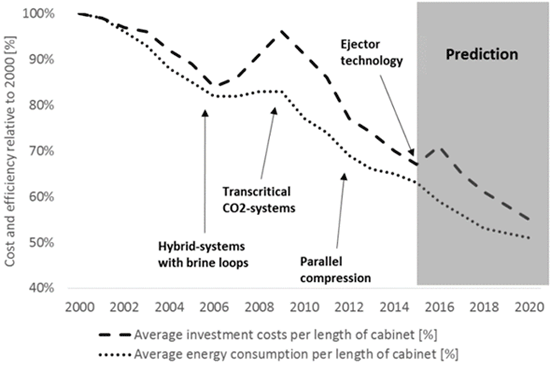



Context - In order to properly measure the stakes related to the use of fluorinated gasses in applications such as refrigeration or air conditionning, it is essential to understand their situation as powerful greenhouse gases and as destroying the ozone layer.
This understanding will also help to manage their impact on climate.
This is a faithful synthesis and summary of several scientific consensus reports. For the full list of sources, see the references.
CFCs (chlorofluorocarbons) are a group of gases that were widely used in refrigeration systems and aerosols, in good part because of their high stability and because they are not very reactive (and therefore not very toxic) from a chemical point of view.
It became clear in the 1980s that these gases were harmful to the ozone layer, mainly through the chlorine they contained, which was released in the upper atmosphere when CFC molecules were broken down by the high energy cosmic radiation. They were thus progressively banned following the Montreal Protocol of 1987 and replaced by other fluorinated gases containing either less chlorine (H-CFCs), which were much less damaging (about 90% less) to the ozone layer because they mostly broke apart before reaching the ozone layer and thus didn’t release chlorine atoms, or with fluorinated gases containing no chlorine at all (hydrofluorocarbons or H-FC). They also had the property of being usable without having to change also the existing refrigeration or air conditioning installations.
These fluorinated gases are also greenhouse gases that contribute to global warming and whose use has since also been regulated.
According to the 2018 report of the Technical and Economic Assessment Panel (TEAP) of the Montreal Protocol1, in preventing the exponential increase of uses in ozone depleting substances (ODS) and especially the CFCs, the world avoided a projected average temperature increase of ~2.5º C by 2070 (~2ºC in the tropics, 6ºC in the Arctic, 4º C in Antarctica). The report concluding that “the twin impacts of the Protocol, on climate and on the ozone layer not only saved the world from catastrophe, but also contributed to sustainable development”.
| Main application areas for hydro-fluorocarbons (H-FC) (UNEP, 2011) |
|---|
|
While the ban on CFCs and H-CFCs has been regulated and programmed globally by the Montreal Protocol, the regulation on H-FCs has been established under the 1994 Kyoto Protocol on Greenhouse Gases. In this context, it is important to note that CFCs accounted for 12% to 15% of total greenhouse gas (GHG) emissions and that the H-FCs that replaced them now account for only about 2% of greenhouse gas emissions. This reduction is the most significant concrete achievement to date in terms of reduced greenhouse gas emissions. Yet it is only rarely mentioned in the debates on the subject because it is not part of the Kyoto Protocol and the Paris Agreement on other emissions of greenhouse gases.

The actions for managing fluorinated greenhouse gases are highly regulated. Due to the Montreal Protocol and its amendments, H-CFCs have been banned from commercialization worldwide since 2015.
The 2016 Kigali Amendment to the Montreal Protocol stipulates that from 2019, the industrialized countries commit to reducing the use of H-FC by 45% by 2024 and by 85% by 2036, compared to 2011-2013 levels. Developing countries will begin to cap and reduce their consumption of H-FC starting in 2024.
The European Union Regulations1 have planned and implemented the phasing out of the CFC and H-CFC fluorinated gases between 1995 and 2015 because of their effect on the ozone layer (see table). In 2014, these restrictions were extended to H-FC gases because of their high global warming potential. The requirements at European level are more stringent than those of the Kigali Amendment, imposing a 69% decrease in their uses for 2024 (rather than 45%).
The ban on the use of H-FCs will not apply, however, to equipment for which energy efficiency gains have been obtained during their operation (notably via the ecodesign requirements of E.U. Directive 2009/125 / EC). In fact 70 to 80% of indirect CO2 emissions from refrigeration systems, for example, are related to their electricity consumption.

1
E.U. Regulation (EC) No 1005/2009 on substances that deplete the ozone
layer![]()
2
![]()
As a result of the ban on the placing on the market of H-CFCs since 2015, volumes of fluorinated refrigerants manufactured in Europe have decreased from around 60,000 tonnes in 2007 to less than 40,000 tonnes in 2015.
In terms of recycling, there is still a long way to go since only 1% of fluorinated gases are collected at the end of their life cycle in Europe (about 1,200 tonnes in 2015) even though recycling units do exist.
As alternatives to fluorinated gases, there are refrigerants called "natural" (CO2, ammonia, propane, zeolite, ...). Used at the industrial level, however, they have limitations to their systematic use because of often dangerous properties: flammability, explosiveness or toxicity.
In addition, a new class of fluorocarbons, the fluids of the category of hydro-fluoro-olefins (HFO) is an interesting alternative with a shorter atmospheric lifetime than that of H-FC and a very low global warming potential. However, there are limits to their rapid adoption: they are classified as "category 2L flammable" and, being patented, represent an additional cost.
It should be noted that as the legal availability of regulated refrigerants decreases and their price increases, there are more and more illegal sales of refrigerants in Europe, especially via Internet sites, and it seems to have only little political will to stop them.
The global energy demand for air conditioners is expected to triple by 2050, in particular due to the increase in hot summer periods, representing an electrical capacity that will be equivalent to the current total capacity of the United States, the EU and Japan united3. In addition, the average energy efficiency of air conditioners on the market remains low (3 times lower than those offering the best efficiency today), and it is even lower in countries with minimum or no energy performance standards in this area.
Although since 2000, energy consumption and the cost of refrigeration systems have almost halved, the global inefficiency of refrigeration and air-conditioning systems has resulted in the loss of two million lives each year, because of damaged vaccines or a high risk of heat stress for about 500 million people or, due to failures in the cold chain, to the wastage of 400 million tons of food.
In order to achieve optimal use of cooling systems, non-state initiatives must accompany actions that are implemented by states to comply with the European and global regulatory agenda.

Some of the practical implementation initiatives for the reduction of H-FC uses and emissions are:
In general terms, a key success factor for the effective implementation of all types of solutions is, in this area as in many others, the collaboration between services and / or between the companies concerned.
For fire protection, companies and organizations that continue to use systems with fluorinated gases have programs in place to identify their most critical needs. Fluorinated gases may be removed from non-critical or obsolete facilities for reuse in more critical applications.
With respect to end-of-life, there are initiatives to upgrade and renovate older and deconditioned extinguishers and fire suppression systems using H-CFCs and H-FCs which recycle or dispose these gases safely.
The refrigeration sector in the broad sense is particularly concerned by an intelligent reduction of the climate impact of fluorinated gases and most of their impact comes from the refrigeration systems of supermarkets4. In the EU, commercial refrigeration greenhouse gas emissions originate indirectly through their energy consumption and directly from their refrigerant-related losses which could represent around 40% of their impact5. This is in particular because the majority are still centralized refrigeration systems which are more leakage prone and, despite their demonstrated benefits, low-carbon solutions other than CO2 are not yet widely applied as refrigerants as they do not appear to be already available for such installations6.
Best practices could both improve energy efficiency and reduce refrigerant emissions by at least 60%.
3
http://ccacoalition.org/en/initiatives/H-FC![]()
4
https://www.osti.gov/biblio/1376485-low-global-warming-potential-refrigerants-commercial-refrigeration-systems![]()
5
E.U. Regulation (EC) No 1005/2009 on substances that deplete the ozone layer:![]()
6
![]()

This summary is free and ad-free, as is all of our content. You can help us remain free and independant as well as to develop new ways to communicate science by becoming a Patron!